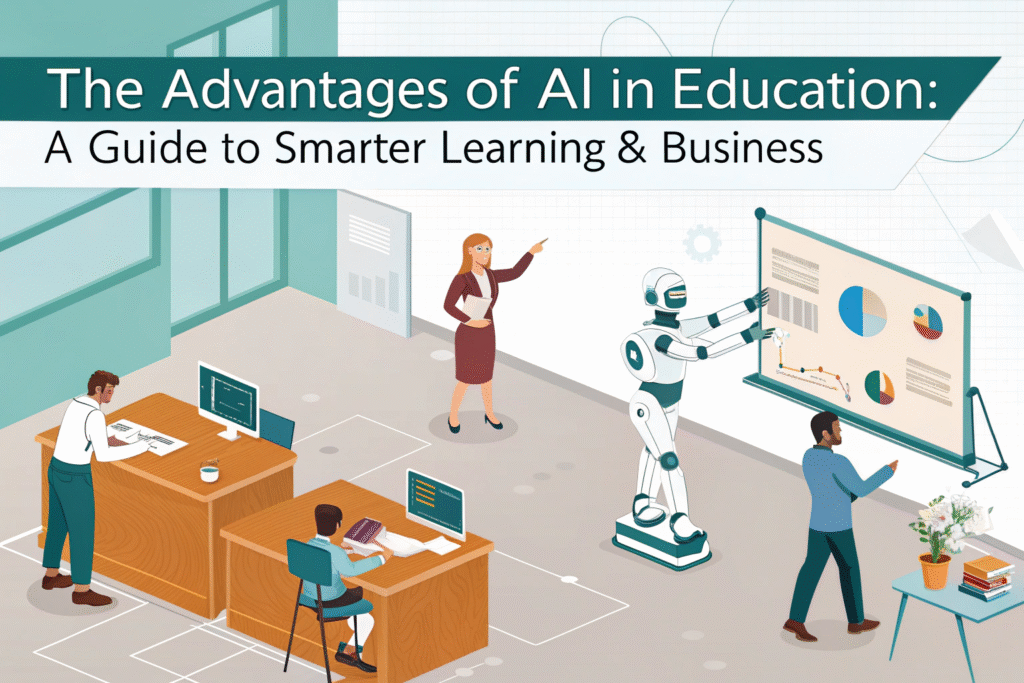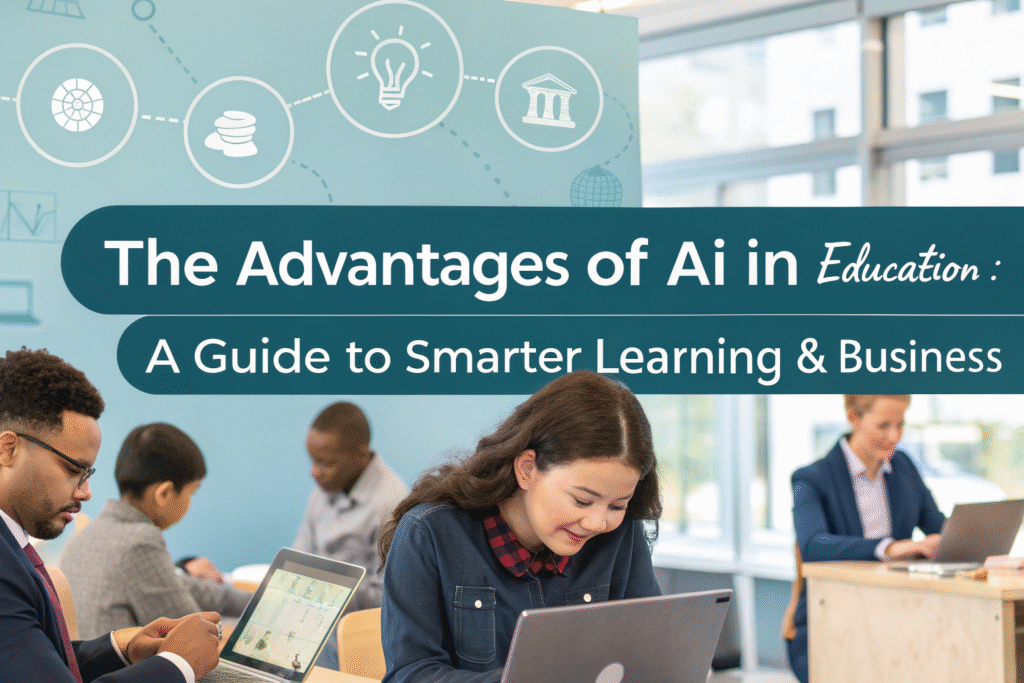
Introduction
The education sector, long characterized by traditional classrooms and one-size-fits-all curricula, is undergoing a radical transformation. The catalyst for this change is Artificial Intelligence (AI). This technology is rapidly moving from a futuristic concept to a practical tool, enhancing learning experiences and streamlining operations. For entrepreneurs, marketers, and content creators, understanding the advantages of AI in education is not just an academic exercise—it’s a critical insight into a massive, evolving market. This article delves into the core benefits of AI, exploring its impact on learners, educators, and the businesses that serve them. We will explore how it personalizes learning, automates tasks, and unlocks new opportunities for innovation and growth.
A Brief History & Evolution of AI in Learning
The journey of AI in education is a fascinating story of evolving technology and ambition. Initially, it began with simple Computer-Based Training (CBT) in the 1960s and 70s, which offered rudimentary drill-and-practice exercises. These systems were limited by their rigidity and lack of adaptability. The 1980s and 90s saw the rise of Intelligent Tutoring Systems (ITS), which attempted to mimic human tutors by providing customized guidance and feedback. However, they were complex and expensive to build. The modern era, fueled by the explosion of big data, cloud computing, and sophisticated machine learning algorithms, has truly unlocked AI’s potential. Today’s AI can analyze vast datasets on student performance, adapt in real-time, and provide insights that were previously impossible, making the advantages of AI in education more profound and accessible than ever before.
Who Benefits? Audience & Demographics
The advantages of AI in education extend across a diverse ecosystem of users, creating opportunities for targeted solutions.
- Students & Learners: From K-12 to higher education and corporate training, learners of all ages benefit from personalized pathways and immediate support.
- Educators & Teachers: AI acts as a powerful assistant, freeing instructors from administrative burdens to focus on teaching, mentorship, and complex student interactions.
- Educational Institutions: Schools, universities, and training centers leverage AI for improved efficiency, data-driven decision-making, and student retention.
- EdTech Entrepreneurs & Businesses: This is the primary audience for this article. This group is building the next generation of learning tools, platforms, and content, using AI to create unique value propositions and gain a competitive edge.
- Corporate L&D Departments: Companies use AI-powered platforms to upskill their workforce, deliver personalized training, and track employee progress with precision.
Key Advantages of AI in Education: Features & Functions
The core value of AI lies in its ability to augment and automate. Here are the key areas where it delivers significant advantages.
1. Personalized Learning Paths
AI algorithms analyze a student’s performance, learning pace, and preferred style in real-time. As a result, they can dynamically adjust the difficulty of tasks, recommend specific content, and therefore create a unique learning journey for each individual. Consequently, this approach moves education away from a standardized model toward a truly customized and personalized experience.
2. Intelligent Tutoring and Support
AI-powered chatbots and virtual tutors provide 24/7 assistance to students. They can answer common questions, explain complex concepts in different ways, and offer guidance on assignments, ensuring help is always available outside classroom hours. For instance, a student struggling with algebra can get immediate, step-by-step explanations without waiting for office hours.
3. Automation of Administrative Tasks
Educators spend a significant amount of time on grading, scheduling, and managing routine inquiries. AI excels at automating these tasks:
- Automated Grading: AI can grade multiple-choice and fill-in-the-blank tests instantly, and is increasingly adept at assessing written essays for grammar, structure, and relevance.
- Administrative Workflow: AI can handle enrollment processes, schedule meetings, and send personalized reminders to students and parents, drastically reducing the administrative burden on staff.
4. Universal Access and Inclusivity
AI tools are powerful enablers for students with disabilities. For example:
- Speech-to-text and text-to-speech functionalities help students with visual or auditory impairments.
- Real-time translation tools break down language barriers for non-native speakers.
- Adaptive interfaces can cater to a wide range of physical and cognitive needs, making learning more inclusive for everyone.
5. Data-Driven Insights and Analytics
AI systems continuously collect and analyze data on student engagement, performance, and behavior. This provides educators and administrators with unprecedented insights:
- Identifying at-risk students who may need extra help early on.
- Understanding which teaching methods and materials are most effective.
- Making informed decisions about curriculum changes and resource allocation.
Business & Marketing Potential
For entrepreneurs and marketers, the education AI market is a goldmine. The global AI in education market is projected to be worth over $30 billion by 2032, indicating massive growth potential.
- New Product Categories: There is immense room for innovation in adaptive learning platforms, AI-powered content creation tools, and sophisticated analytics dashboards for schools.
- Content Marketing: Businesses can leverage AI to create highly personalized and engaging learning content, from interactive simulations to adaptive video lessons, setting themselves apart from competitors.
- B2B Sales: Marketing to educational institutions requires demonstrating a clear return on investment (ROI). AI tools that can prove they improve student outcomes, reduce dropout rates, or save administrative costs are highly compelling.
- Subscription Models: AI-powered platforms are perfect for Software-as-a-Service (SaaS) business models, creating predictable, recurring revenue streams.
Best Practices & Tips for Implementation
Successfully integrating AI requires a strategic approach.
- Start with a Problem, Not a Technology: Identify a specific pain point in education (e.g., high dropout rates in math courses) and find an AI-driven solution for it.
- Prioritize Data Privacy and Security: Educational data is extremely sensitive. Ensure your product is compliant with regulations like FERPA (Family Educational Rights and Privacy Act) and GDPR (General Data Protection Regulation) and be transparent about data usage.
- Design for the Human-in-the-Loop: AI should augment, not replace, educators. Design tools that empower teachers with insights and save them time, rather than making them feel obsolete.
- Ensure Explainability: Avoid the “black box” problem. Educators and students need to understand why an AI is making a specific recommendation to trust it.
- Pilot and Iterate: Test your AI solution with a small group of users, gather feedback, and refine your product before a full-scale launch.
Challenges & Limitations
Despite its potential, AI in education faces significant hurdles.
- High Initial Investment: Developing and implementing effective AI solutions can be costly, creating a barrier to entry for some institutions and startups.
- Data Bias and Fairness: AI models are trained on data. If this data contains historical biases (e.g., gender or racial stereotypes), the AI can perpetuate and even amplify these inequalities.
- Over-reliance on Technology: While technology offers many benefits, there is a risk that the human element of teaching — including mentorship, inspiration, and social-emotional learning — could be diminished if it is overused. Consequently, educators must strike a balance between leveraging digital tools and maintaining meaningful human interactions.
- Digital Divide: Unequal access to technology and high-speed internet could mean that the advantages of AI in education are only available to privileged students, exacerbating existing educational inequalities.
The Future Outlook
The future of AI in education is intelligent, immersive, and integrated. We can expect to see:
- Hyper-Personalization: AI will move beyond academic content to consider a student’s emotional state, motivation, and social context to tailor the learning experience.
- AI-Powered Content Creation: Educators will use AI tools to generate lesson plans, quizzes, and interactive learning materials in minutes. This means tasks that once took hours can now be completed quickly and efficiently.
- Wider Adoption of Predictive Analytics: Institutions will use AI not only to identify struggling students. Additionally, AI can predict future performance trends and help optimize entire curricula.
- Emergence of Generative AI Tutors: Advanced AI, such as large language models, will power highly sophisticated tutors. These tutors can conduct open-ended, Socratic dialogues with students.

Conclusion
The integration of AI into education is no longer a speculative trend; it is a present-day reality with undeniable momentum. The advantages of AI in education—from creating deeply personalized learning journeys to freeing educators from administrative drudgery—are paving the way for a more efficient, effective, and inclusive educational ecosystem. For entrepreneurs and businesses, this represents a monumental opportunity to build innovative solutions that address real-world challenges. However, this journey must be navigated with care, prioritizing ethical considerations, data privacy, and the irreplaceable value of human connection. By embracing AI as a powerful tool for augmentation, we can unlock human potential and build a smarter future for learners everywhere.